
17 minute read
Company Profile
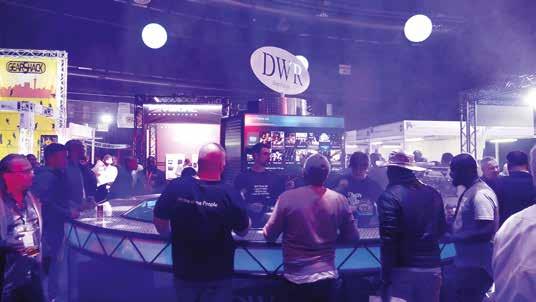
Mediatech’s 2019 booth put conversation and networking at the forefront with an ‘in-the-round’ format
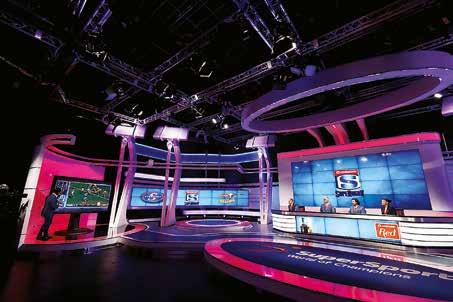
SuperSport Studios got a complete DWR makeover in 2018

DWR’s main offices in Honeydew SuperSport Studios got a complete DWR makeover in 2018
The relationships that are built
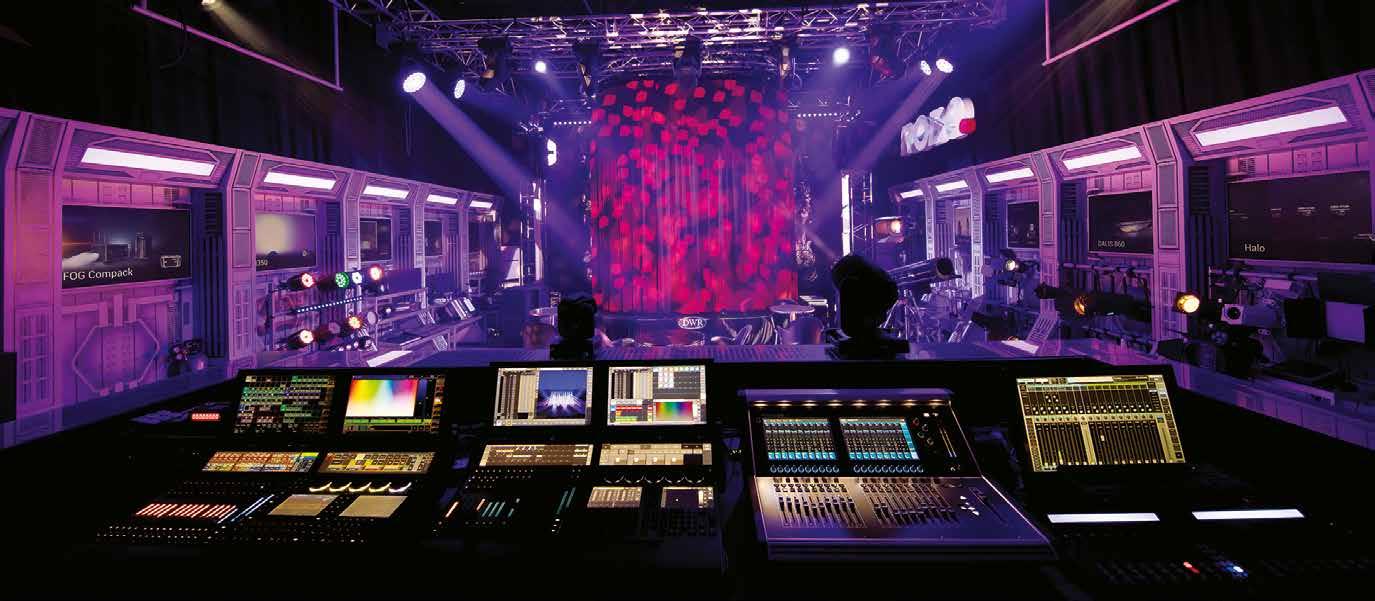
The company’s product demonstration room
Starting life as a modest lighting distributor, DWR Distribution has charted an exciting path in its goal to becoming a one-stop shop for entertainment and architectural fields, discovers Becky Abel
For the past 13 years, DWR has put people first. Despite a rocky start launching the company and attaining its first brand, DWR has flourished as a South African distributor, consistently broadening its portfolio of brands to offer all-new solutions, and even going so far as to directly support the local entertainment industry through the creation of the SOS Charity. None of this would have been possible without the vision of an amazing team, headed by Duncan Riley.
After 11 years of working at Electrosonic, still the South African distributor for Harman’s Martin Professional brand to this day, Riley made the decision to resign from his role as a director and set his sights on something new. His garage at home quickly became the office and, in 2006, DWR, an abbreviation of Riley’s initials, was born with help from wife Sherryn and local freelance technician Nick Britz. But everything hinged on the support of one person, Robe’s international sales director, Harry von den Stemmen. As the main rival to the Martin brand in the region, von den Stemmen and Riley were already well acquainted. ‘Harry was our biggest to meet co-founder and CEO, Josef Valchar. The rest, as they competition; however, he wasn’t selling much because we were doing such a good job on the Martin side,’ jokes Riley. ‘Whenever he’d come to South Africa, we’d always make time for a drink together at the pub of rental owner Mike Jones from MJ Event Gear, even though we were competitors. Over the years, he’d asked me several times whether I would be interested in working with Robe.’
Counting on von den Stemmen’s support, Riley was working on a project for Metallica who were performing in South Africa when he called Harry and asked if he was ready to distribute Robe.
At first, von den Stemmen thought he was joking. ‘I was quite taken aback by Harry’s response. I was thinking, oh my gosh, my daughter’s just been born, I’m unemployed and I’ve got no real plan. It was a worrying time.’
After realising Riley was serious about taking on Robe, von den Stemmen invited him to the factory in the Czech Republic say, is history.
In the years since, DWR has been successful in helping specify Robe on all kinds of projects in South Africa, while growing to encompass 60 permanent staff members. ‘Everyone who works at DWR is a cool, sociable person that’s easy to get on with.’ This includes Riley’s partners, technical director Bruce Riley and sales director Robert Izzett. ‘Robert and my brother Bruce are
two of my most important guys in the business,’ he comments. ‘DWR wouldn’t be what it is without these two, the staff and all the other people that make it work.’
As the company started to become more successful, it quickly moved to warehouse premises in Strijdompark, Randburg and is currently based in a 3,000m 2 unit in LaserPark, Honeydew with ourselves with some nice brands, always with the manufacturer approaching us, and everything has all just fallen into place.’
This is surely the result of the personal approach DWR takes to doing business. Relationships have always been important to Riley and his team, so much so that it has become the company motto, It’s all about the people. ‘The relationship with your client, the relationship with your supplier, it’s all a people thing,’ he adds. ‘Equipment comes and goes but we need to maintain relationships with our clients. At the end of the day, we are here to protect their interests and, if you look out for them, hopefully their business will come back to you.’
After 10 years focused on lighting distribution, DWR took its first steps into the world of professional audio in 2016. Ian Staddon, VP of sales at DiGiCo, was in South Africa searching for new partners. Staddon saw several rental companies on his trip and, when he asked who he could talk to about potential distribution, was recommend DWR by each and every company.
That a manufacturer like DiGiCo threw its weight behind a distributor with no audio experience shows the power of DWR’s personal approach. The partnership came on the condition that someone would be appointed to ‘do the product justice’. Riley approached Kyle Robson, who was already working with the brand for the previous distributor, and brought him under DWR’s wing.
However, this was just the beginning of DWR’s venture into audio. In 2018, it became the South African distributor for L-Acoustics, another high-profile audio brand that commands a lot more than simple box shifting. This was on the recommendation of Gearhouse’s Ofer Lapid, one of the French manufacturer’s biggest users in Africa. As with DiGiCo, Riley sought a dedicated DWR representative that could nurture the brand, and one of Sound Harmonic’s owners, Richard Smith, was quickly brought on board.
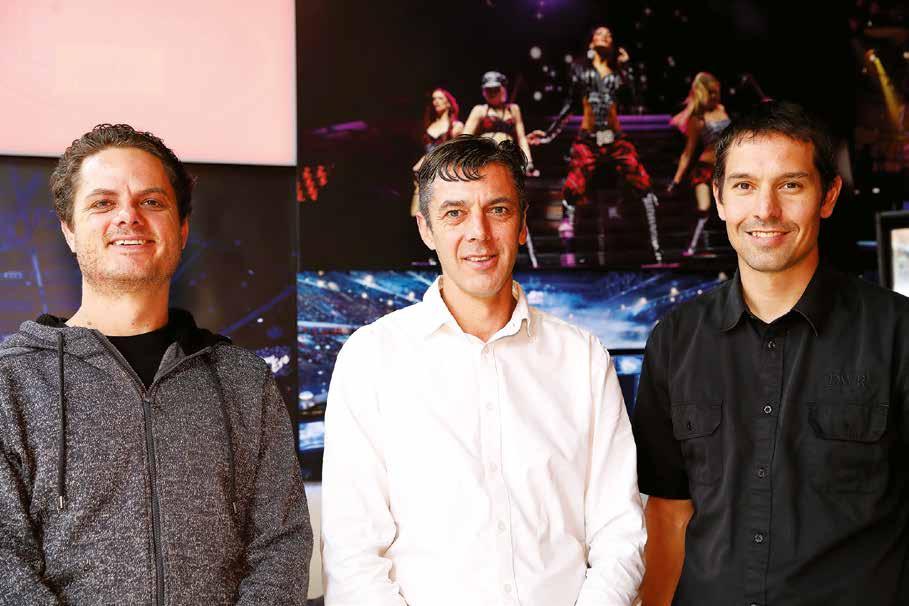
Bruce Riley, Duncan Riley and Robert Izzett
DWR’s portfolio of audio products was starting to become a heavyweight. But when it comes to the biggest projects and events, there was still a missing piece, a flagship communications system. ‘People here in South Africa really want a one-stop shop,’ states Riley. ‘They want to stick with a supplier that they feel comfortable with and we had nothing in our inventory for comms.’ With a couple of possible options on the horizon, it was another personal relationship that sealed the deal.
‘I was supposed to meet with Richard Palmer from Clear-Com at Mediatech last year, but the deal was sealed over a phone call after the event,’ says Riley. ‘There’s just something about Richard that came through in his personality. I felt good about the company and the person I was speaking to.’
The enviable selection of brands the company has amassed over the years has seen it involved in many of the popular and high-profile events gracing the continent, originally in theatre and houses of worship, but increasingly on prime-time television programmes like Idols, a project it has been involved with since the beginning. DWR has also worked on shows such as The Voice South Africa and will be working on Family Feud in the near future. ‘It’s so awesome to walk into the show and, because we have supplied every single piece of equipment, it essentially feels like a our showroom. The most exciting thing for me to this day is to go to a show, see my clients and see your kit. It’s just something special.’

DWR helped support the first South African L-ISA production on The Voice earlier in the year
DWR takes its role in supporting the local AVL industry a little more seriously than most, and, in 2016, co-founded the SOS Charity Fund. Staddon had made Riley aware of a charity in the UK that provided assistance to individuals working in the entertainment industry that had fallen on hard times, for whatever reason. After recognising that a charity such as this was needed in South Africa, DWR established the SOS charity. ‘We get phone calls about the SOS Fund all the time and it’s such a wonderful thing to be involved with. It’s not all about business and money, it’s about helping people.’
Once again, as Riley jokes, it always comes back to the people. But that really is the essence of DWR – a company that is quite literally the product of the many personalities it’s home to. If he questioned whether he was making a sensible decision to go it alone back in 2006, Riley should be humbled at the fruits of his hard work. ‘It’s been a wonderful ride,’ he smiles. ‘I wouldn’t change anything and I’m looking forward to what the future holds.’
The band plays on
As Powersoft reaches its silver anniversary, the company’s founders reflect on how it’s more than just amplifiers that have powered the company
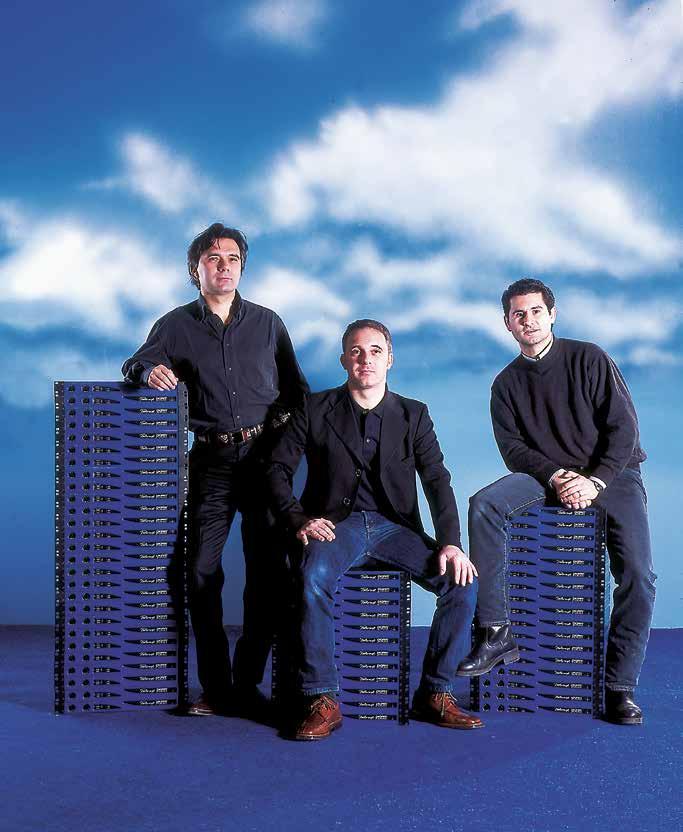
In the beginning: Luca Lastrucci, Claudio Lastrucci and Antonio Peruch

Twenty-five years later and still going strong
Powersoft's colonisation of the professional power amplifier arena would take time to explain to an industry outsider. Dominated by a host of C-initialled manufacturers, the amplification landscape of 1995 was inhabited by heavy toroidal transformers offering industrial strength weights and designs with a varied track record of reliability. Today, the brand may be synonymous with power amplifiers and modules, but this is no indication of where its onward mission will take it.
It was all very different during those formative years at PLASA and Prolight + Sound Frankfurt. Together with his companion, Luciano Ciappi, Powersoft founder and president Carlo Lastrucci would receive bemused looks while promoting the company’s sleek Digam models. Channelling the energy levels of his products, Lastrucci remained unfazed, committing himself to taking the brand to unimaginable peaks – without clipping.
The cornerstone of Powersoft’s success has always been based upon full ownership, which has allowed the company to pursue a passion for engineering. However, when brothers Luca and Claudio Lastrucci graduated from their electronics engineering degrees, Luca, the elder by two years, was absorbed in software and the possibilities of artificial intelligence, while electronics engineer Claudio was fascinated by power management and hardware. Although the brothers shared a passion for music, playing drums, piano and guitar together in pubs and bars, there was little to bind them together in terms of business.
Having decided to start a company with Claudio’s long-term friend, Antonio Peruch, the trio looked at their wide-ranging skills and interests, and elected to try a little of everything. ‘It was supposed to be an engineering company,’ recalls Claudio. ‘It was the three of us collecting projects from various customers and doing the designs for many strange things. Not only audio devices, but automatic voice recognition systems, software, power conversion technologies and supply systems, conducting the installation of software and so on. Then we stopped and thought about what we could do.’
The name itself was easier to choose, reflecting the partners’ twin interests of power and software. ‘It was fun because we gained an insight into many different topics and technologies,’ adds R&D director Claudio. ‘We came to understand how to approach different technological problems and how to solve them.’

Musicians from the beginning, the future business partners play a gig in November 1983
Reflecting the fact that it has always seen itself as a developer of technology, at no point did the fledgling company decide to align itself exclusively to audio. However, Claudio and Antonio went on to pioneer the amplifier side of the company and its associated production processes, while Luca helped to revolutionise the public transport mobility system across much of Italy.
As time progressed, ideas often flourished that would sow the seeds of patented technologies. Power Factor Correction (PFC), Differential Pressure Control (DPC) and other innovations hatched around the company’s humble kitchen and the Lastruccis’ dinner tables overcame new brand scepticism. However, it was the development of Switch Mode Amplification that clearly marked Powersoft’s arrival in the professional industry.
‘When we saw the potential of Class-D, we knew that we could attain huge power ratings,’ states Luca. Applying it to the professional market changed the rules of professional amplifier design. Although not a new technology, its application within the audio domain had been stunted and lacked a finished product until the Digam series was unveiled.
‘Nowadays, if you don’t have a switch-mode amplifier then you are virtually out of the market,’ explains Claudio. ‘But at that time it was a huge leap of faith. As a young company, we knew what we had was unbelievable and I was sure that within two years the whole world would be working with switch-mode technology. It did eventually happen, but it was more than 10 years later.’
It’s hard to believe that Powersoft has now been in existence for 25 years. But the relatively short, yet impressive, time span has been enough to convince users that green, Class-D power in a 1U chassis was an investment worth making. ‘It was difficult in those early years because audio engineers are quite conservative with a fear of failure of new technologies,’ recalls Claudio.
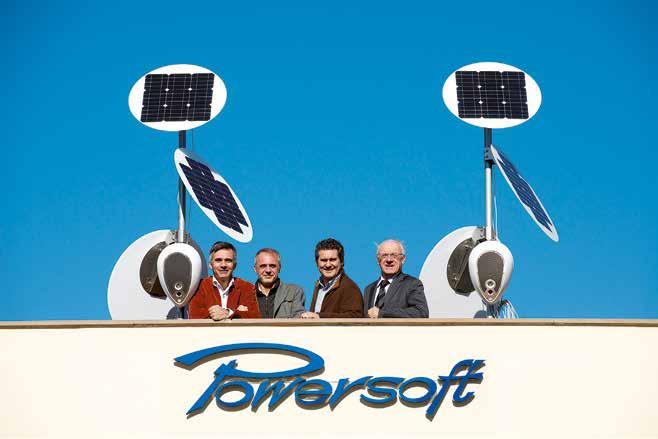
The management team on the factory roof, complete with Deva units

Powersoft’s Scandicci HQ at night
‘The word “digital” 25 years ago was worrying because it was still in the early stages of adoption within the audio business. That design was an analogue modulation, but a fear existed that it could destroy the performance of the entire sound system. Education was vital in allaying those fears. You’re asking someone to trust you, but if they don’t understand you, it won’t work. Therefore, you have a duty to explain how your software, processing and other specific product behaviour operates and what benefits they bring. An amplifier is more than a datasheet – it’s a complicated piece of machinery that requires a lot of training. Without it, your brand development is stunted.’
As a family business, the market turbulence perhaps motivated Powersoft to power on to greater fortunes. The yesteryear C-initial manufacturers have largely been either cannibalised or consumed by larger brands. Perhaps Powersoft was simply more ambitious and opted to invest when others were cashing in. ‘We switched from THD to SMT technology as it provided more reliability and quality in production,’ says Antonio.
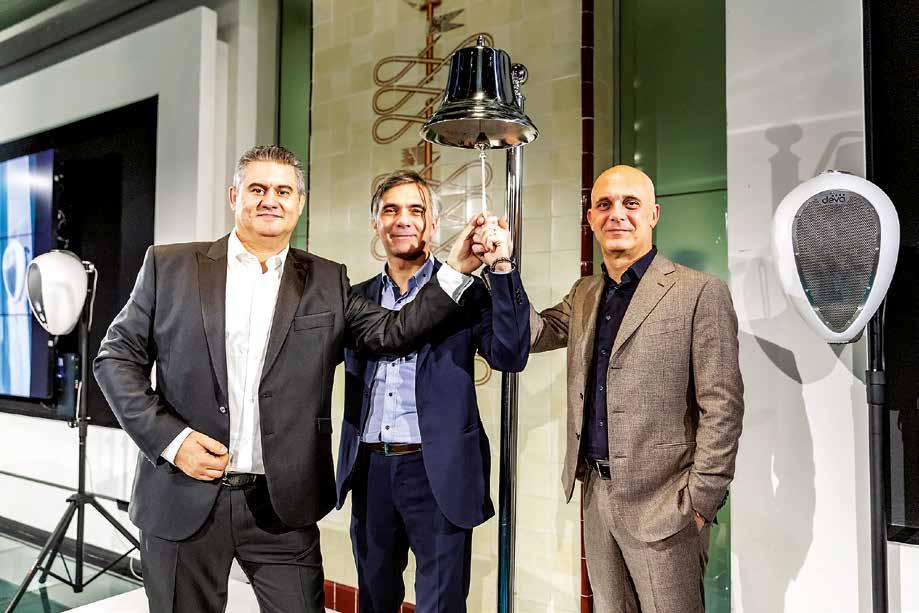
The company floated on the Italian Stock Exchange in December 2018
‘Then, in 2007, we increased the gap with our competitors by becoming the first manufacturer to introduce on-board DSP in our products, together with intelligence, firmware and software as we continue to create a smart product. In the past five years, we have introduced powersharing capabilities within our products that can be accessed via the Armonía system manager software. Ultimately, this will create an ecosystem for our products, while greatly benefitting our customers in the field.’
Without stopping to rest on its laurels after the success of Digam and the K Series, Powersoft’s innovations have since escaped the conventional modules and chassis in the form factors of the networked multimedia Deva, together with M-Force and Mover, making earth shaking an art form. However, as a force of innovation, the next stage of the company’s evolution remains unclear. ‘Both M-Force and Deva are good examples,’ continues Claudio. ‘We like to develop ideas that are allied to, but nevertheless outside of, the amplification niche.’ Deva, the manufacturer’s solarpowered tour-de-force of technologies, incorporates an 8-inch speaker and Class-D amplification for BGM and paging, plus video surveillance capabilities, Wi-Fi and GPS in addition to other features. The system is unlike anything else in the market. ‘But it’s still within our core competences,’ reasons Claudio. ‘With our mobility division, the software, our systems knowledge and audio, of course.’
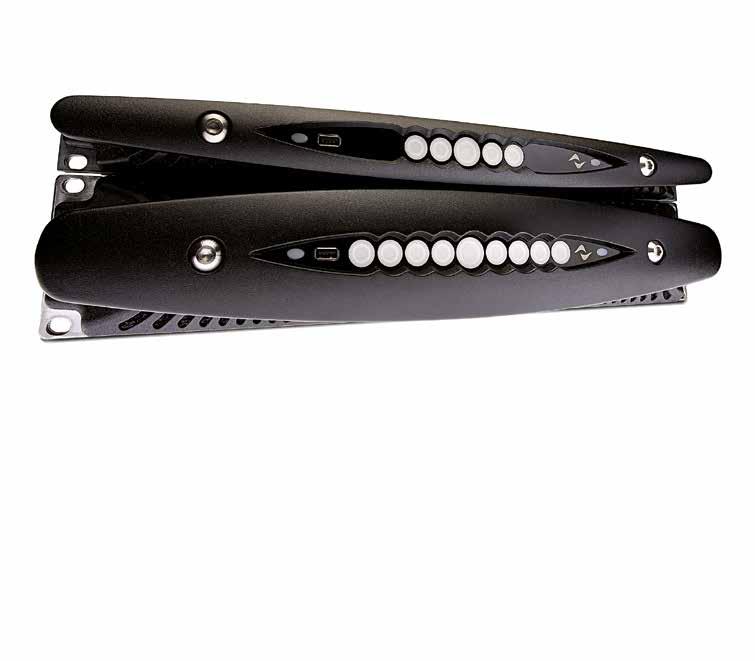
The striking X Series
Powersoft did not devise M-Drive as its entry into the woofer and transducer business, however. ‘Both our strategy and our interest is to provide the technology, rather than the final product,’ explains Luca. The direct descendent of M-Force, Mover, was unveiled in 2019. ‘We identified a gap in the market that was available and decided to fill it,’ he adds.
Described by the company as a true push–pull moving magnet transducer, M-Force is based on switch-mode principles with the added benefits of 25 years of improvements in technology, new materials, increased DSP power and the creation of Differential Pressure Control. When used alongside the accompanying M-Drive to create the M-System, it can form the backbone of a highly unique subwoofer. ‘We believe that M-Force is a revolutionary technology for subwoofers,’ explains Luca. ‘It will be like Class-D – everybody will eventually use it.’
With attention on the rising Tuscan star mounting, sales rose as its distribution network expanded. Less akin to empire building and more to managing unprecedented growth, the modest Scandicci office on Via Enrico Conti has expanded beyond the original no.5 and now continues to the end of the street. Satellite offices were established in Singapore and New Jersey from 2008 to provide localised servicing, sales and technical support for the Asia Pacific and North America markets, respectively. ‘The K Series was really our passport into the US and, as such, we had to increase our level of support there,’ confirms Claudio.
Similarly, the company’s Florence-based workforce has taken on a more international flavour over the past decade, with renowned technical, engineering and sales support. ‘Powersoft has been continually growing and we need to find the right resources,’ adds Luca. ‘However, as a technical company, you cannot rely on Tuscany to find the right people with wide skill sets, so we looked outside of Italy. All we ask of them is to learn Italian and enjoy eating Italian food!’
Likewise, the expanding manufacturing capabilities had to mirror the company’s ambitions – a formidable task kept in check by production engineering and project management director Antonio. ‘The main plant near Bologna produces phase-out rack amplifiers and PCBAs [Printed Circuit Board Assembly] for Quattrocanali, Ottocanali and Duecanali models, while the modules are manufactured in the north, close to Gorizia,’ he explains. ‘Another plant to the south of Tuscany is equipped with PCBAs for production and there is another highly automated plant based on Lean production close to our headquarters in Scandicci. Here, we conduct the final assembly and testing phases prior to shipping.’
As a respected amplifier manufacturer, collaboration with other producers remains pivotal in the company’s ongoing success. ‘We have always considered a sound system as one unique thing,’ explains Claudio. ‘The fact that we don’t build speakers doesn’t mean that we don’t take care of what’s inside a speaker or what transducer behaviour is, so it’s important to have cooperation both with customers and other manufacturers to provide a better solution.’ The fact that Powersoft is still perceived as an amplifier company doesn’t frustrate him. ‘Once you know what goes into an amplifier with processing software, hardware, power, compliances, speaker knowledge and so on, you become quite qualified in understanding other technologies and problems that need to be addressed in the signal chain.’
There appears to be no secret formula for staying ahead of the technological curve. ‘No general method can be applied, but you can stimulate the careers of people with different skill sets,’ explains Claudio. ‘We work with universities and with specific companies that provide new technologies, while continually developing within Powersoft. When combined, they will reap benefits at some stage over the next 10 years and hopefully break conventional engineering.’
Twenty-five years on, Powersoft continues to be a family business, but everything changed in late 2018 when it was listed on the Italian Stock Exchange. ‘This was a challenging project, but it was also very important for us,’ recounts Luca. ‘We decided that we needed to be armed with a trigger that would allow us to jump into the future, to change our culture internally and our internal processes in order to prepare the company for future challenges. Rather than being the end of an era, it’s a new start, offering transparency for our partners and customers.’
As the company that started in a garden shed looks to relocate to new, bigger, purpose-built premises in 2020, its founders’ discarded musical instruments appear to have gathered dust. ‘The three of us started with an idea and, after 25 years, we’re immensely proud to be where we are now – a leader in the professional audio market,’ Luca comments. But it would seem that success comes with a price. ‘We loved playing music together, but we have no time for that now,’ he adds. ‘Perhaps in the future there will be the opportunity to play together again.’ Given the momentum that Powersoft has maintained, this unique ensemble is more likely to be generating pink noise rather than light jazz. However, Claudio can’t resist a nostalgic glance at his kit. ‘Maybe it’s time to get back to the drums,’ he remarks, suggesting that among all the ingredients contributing to Powersoft’s success, the musicality of its founders is not to be underestimated.










